We recently had our third Coffee Master Journey class at Molly Pitcher Travel Plaza. The class was facilitated by Mike Penna (Company Operated Store Manager/Coffee Master from NYC). The team brought in many exotic and unusual coffees for us to taste along with new projects to be presented.
(Maykol & Julie Presenting their project)
(Maykol & Julie's project)
Julie and Maykol started off the run of presentations with their project on the difference between Arabica and Robusta. Their poster board was very informative and included information a lot of people in the class never knew before, especially about the Robusta species of coffee trees. For their paring they picked a Starbucks Reserve Sun-Dried Sumatra Rasuna which is a naturally processed coffee that has a "winey" aroma with a distinct berry profile and was a coffee favored by most for it's aromatic nature and complex flavors. Paired with cranberry orange scone, the Sumatra was smooth and the citrus notes in the pastry brought out the berry flavors in the coffee. The other coffee they picked was Nescafe Instant Coffee which had a blend of Robusta and Arabica coffee to give us a taste of the robusta coffee. Their project came out awesome and they did a great job teaching the team about the difference between the Arabica and Robusta species!
(Roberto, Manny, & Mike (Holding the iPad)
(Manny & Roberto presenting their project)
Roberto and Manfred's project was on the growth of the coffee tree and cherry. They split up their project into two separate presentations. The first was on the growth of the coffee tree in which they made a model of each step through out the tree's life until it becomes fruit bearing.
(Manny & Roberto's model of tree growth)
The models had precise detail and really gave the class a nice up-close visual of what the tree looks like from seedling to an adult tree.
The second part of their project was a powerpoint presentation on coffee cherry growth. They explained the life of a bean named Jim, from being an unripe baby to an adult ready to be picked. The project was hilarious and really taught the whole team about cherry growth from another perspective!
(Roberto & Manny preparing the coffee tastings)
For Manny and Roberto's tasting, we had a Starbucks Reserve Panama Paso Ancho which was paired with cinnabons and had an incredibly clean finish with a nice cocoa profile. The pairing brought out the soft spice in the coffee and was a perfect conclusion to their presentation.
(Jay & Jordan presenting their project)
(Jordan)
Jay & Jordan's project was about the anatomy of the coffee cherry and processing. They presented a couple videos off the internet on Washed, Semi-Washed, and Natural Processing. (Links below)
(Video on Washed Processing)
(Video on Natural Processing)
*Click on youtube links under title to watch*
Washed Processing (Used For Project)
http://www.youtube.com/watch?v=fPxf8scXEkg
Semi-Washed Processing (Used For Project)
http://www.youtube.com/watch?v=YQvf8lmCqoU
Natural Processing (Used For Project)
http://www.youtube.com/watch?v=Dolwc93JFdg
*Click on youtube links under title to watch*
Washed Processing (Used For Project)
http://www.youtube.com/watch?v=fPxf8scXEkg
Semi-Washed Processing (Used For Project)
http://www.youtube.com/watch?v=YQvf8lmCqoU
Natural Processing (Used For Project)
http://www.youtube.com/watch?v=Dolwc93JFdg
The coffees they brought in for the tasting were a Starbucks Reserve Peru Aladino and Maui Mokka. The Peru was paired with an orange to bring out the citrus notes and sweetness of the coffee and the Maui was paired with chocolate covered espresso beans, the Maui had distinct cocoa flavors with a bright acidity; the chocolate covered espresso beans mellowed out the coffees acidity and had a nice crisp finish.
(Manny & Mark are impressed)
(Mark & Stacey presenting their project)
Lastly, Mark Ormsbee (Licensed District Manager/Coffee Master) & Stacey Carpenito (Licensed Brand Champion/Coffee Master) presented their project on grading and sorting of the green coffee beans. They made awesome handouts for their presentation that included pictures from Mark's trip to Costa Rica and tons of information on how coffee is graded and sorted before being sent out to roasting plants.
(Mark & Stacey presenting their project)
(Their coffee pairings!)
For their coffee tasting they did a Starbucks Reserve Ethiopia Sidamo and Starbucks Casi Cielo paired with a cannoli and an apricot/raspberry almond cookie. The ethiopia had a perfume like aroma with a huge punch of flavor from a deep chocolate to dark cherry and paired excellently with the almond cookies. The Casi Cielo (Translated from Spanish=Almost Heaven) was robust with an indulgent flavor profile and the rich cannoli was a great pairing for what we consider a "desert" coffee.
(Mike facilitating the class)
The amount of coffee knowledge this class has so far is immense. We are all teaching each other new information every time we meet, and the conversations keep getting better and better. The next class we will talk about how Starbucks buys coffee and the practices they use to do business.
Thanks to Mike Penna for facilitating the class!
Thanks to every one for sharing their projects!
The next class will be held at James Cooper Travel Plaza on April 11th at 2pm. We will be presenting projects on Starbucks Coffee Buying, bringing in Starbucks Core Coffees or Competitor Coffees for tastings, and sharing our action plans to sell coffee!
Activity: Find an interesting fact about each of the subjects and post a comment!
-Arabica/Robusta Trees
-Coffee Tree/Cherry Growth
-Processing
-Grading/Sorting
Can't wait to see the comments!
-Jordan
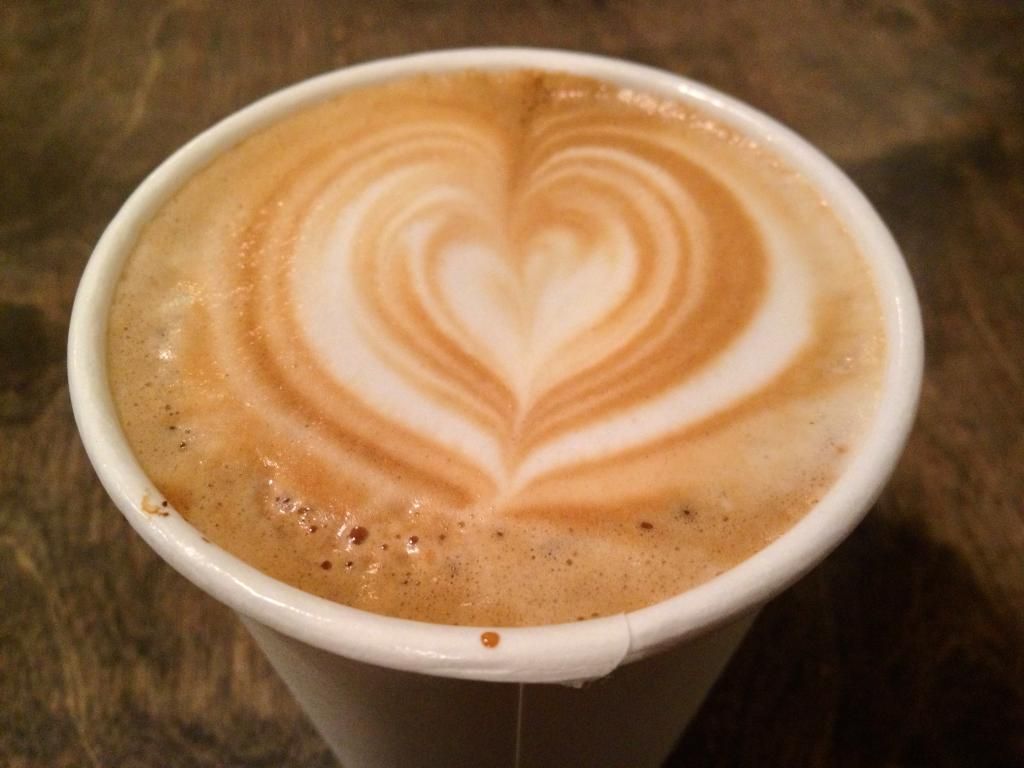
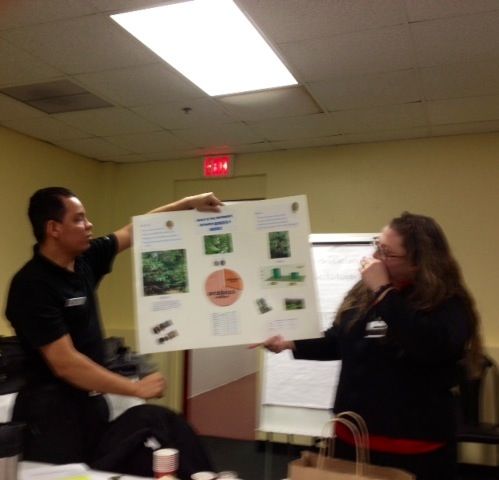


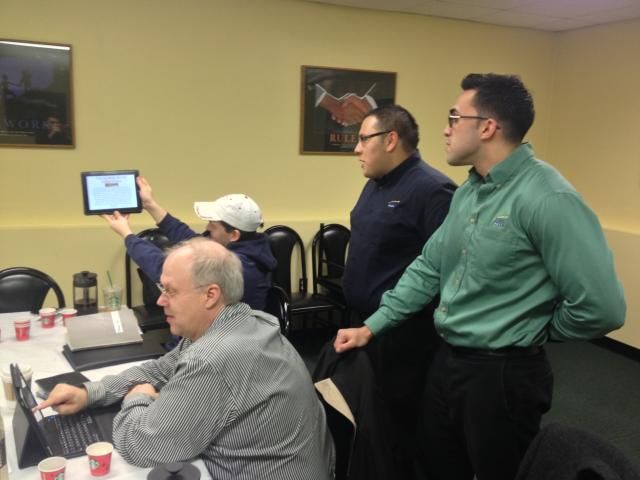
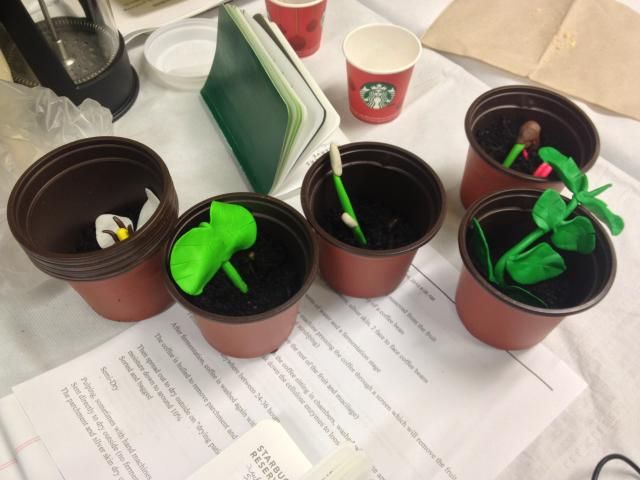

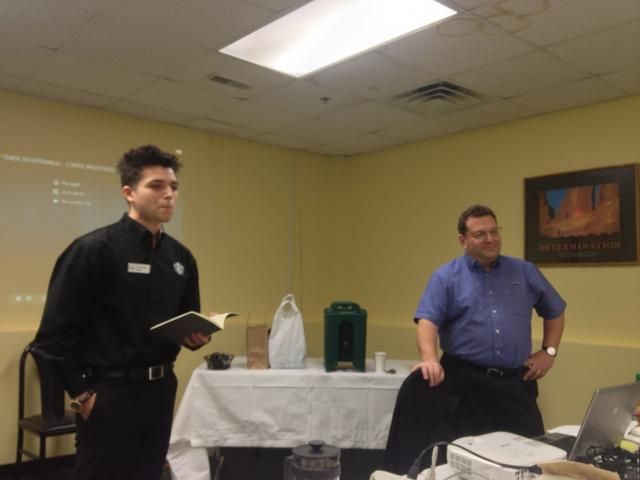
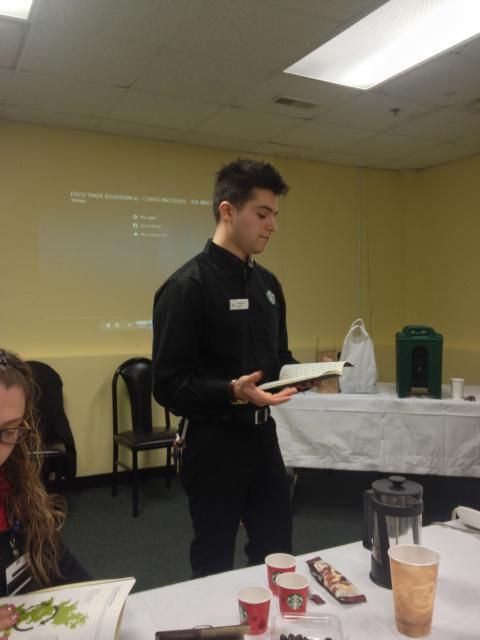
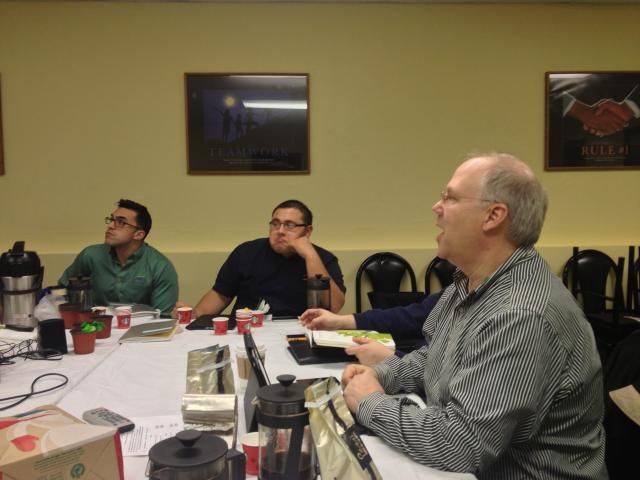
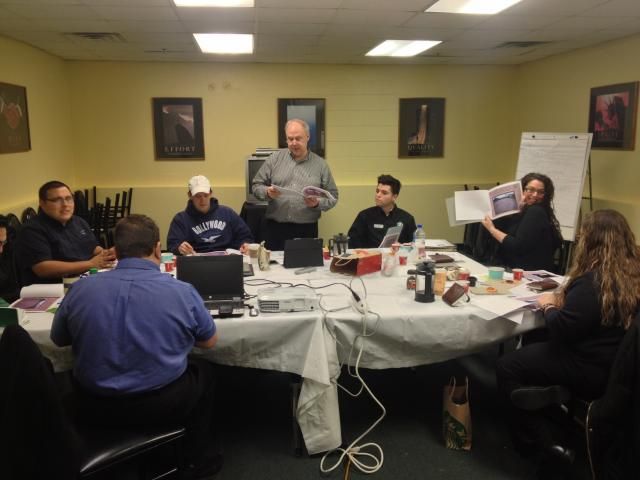

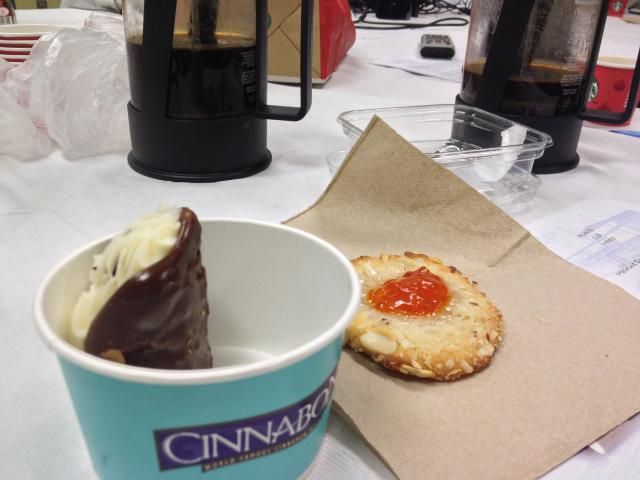
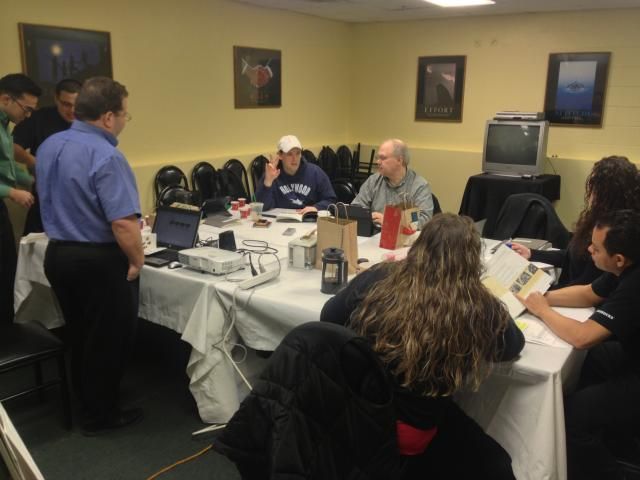
Wow this looks so amazing, and the class was great. Everyone was so well prepared and the projects were amazing!
ReplyDelete* Robusta trees do not get as much disease as Arabica trees, and produce a larger bean lighter in color.
*There are 4 types of trees Bourbon, Typica, Caturra and Catuai. The original pure breds are Bourbon and Typica.
*The fermentation step in the washed method is what causes the increase of acidity in the coffee. Since the washed method is used in most Latin American coffees they are high in acidity.
* Depending on how coffee is bagged, the coffee beans can be vulnerable. If they are poorly stored they can develop a burlap taste and some of the positive qualities can fade.
Cant wait for everyone to see what a beautiful store James Cooper is and taste more coffee!!!
I really enjoyed this class and look forward to the next one. Very interesting information presented in differant and entertaining ways.
ReplyDelete*Robusta Coffee Flavor is typically inferior to Arabica but almost half of the coffee growing world cultivates Robusta because it is more accessible.
*Coffee trees typically takes 4-5 years to reach maturity and then begins the yearly cycle of producing coffee cherries.
*Due to increased environmental awareness, in many cases the fermintation step in wet processing (which uses lots of water) has been replaced by removing the mucilage mechanically.
*In additon to eliminating broken, small, and defective beans, density sorting also removes stones and any other debirs that found its way into the batch.
we got lots of pictures and stories in this class. it was fun. I enjoy working with Julie in these projects and its great to share them with everyone.
ReplyDelete* Arabica beans - It was interesting to find out that it is lower yielding than its counterpart and only grows to about half the size of the Robusta plant. you have half the plant with half the yield. It grows well in a temperate and controlled climate and the Arabica plant also requires more attention and care.
* it was so cool so see the youtube videos about processing coffee. didn't know that natural method was all done by hand. and also, it was good to see how much time people spend processing and handling coffee just to get it right.
see you guys soon
•Arabica- has less caffeine than robusta. Arabica coffee is mostly grown at high elevations however Starbucks Reserve Gálapagos San Cristóbal is grown as low as 450 meters.
ReplyDelete•Coffee cherries for through a nine month process from flowering all the way to harvesting and it happens at different times of the year around the world.
•Natural processing is my favorite. Flavor varies from coffee to coffee because the cherries and laid out to dry on the bean giving the coffee unpredictable and berry favors.
****This just in**** Starbucks has bought a 600-acre farm in Costa Rica to develop mew coffee varieties and test methods to eradicate coffee rust which is hurting the industry - Wall Street Journal
that's an interesting news. I wonder what methods and procedures Starbucks will be using. also, that's a great investment for Starbucks and Costa Rica when the result come out. new coffee to add to our journey =-)
DeleteWill Starbucks be selling any coffee from this farm? Or will it be exclusively for their research only?
Delete-Jordan
I was extremely impressed with the class and learned alot from the presentations. See you all on April 11th.
ReplyDelete*Robusta Trees grower and low altitudes and warmer temperatures. The bean has a less distinctive flavor and retails at a lower price point.
*A Coffee tree can live up to 100 years however, the tree only has 20-25 years of productive fruit bearing.
*As Environmental Awareness has increased over the years, in many cases the fermentation process in wet processing has been replaced with removing the mucilage mechanically. This process uses less than 5% of the water used in the traditional fermentation step.
*A density sorter not only removes small, underdeveloped beans but also any stone and debris that has found their way into the batch.
What a great blog this is! I hope you don't mind "outsiders" peeking in. :) Actually, I'm in Texas and am also on my CM journey and found your blog while looking for some general CM information. Your projects are fantastic, y'all!
ReplyDeleteHey Denise, thanks for the kind words on our blog. Feel free to add anything to our posts that you have learned, and if any of your partners are going through the Coffee Master process as well, give them the link to this blog, we would love to hear what you guys have learned so far!
Delete-Jordan
Hey Guys
ReplyDeletethis was such a fun class and the pictures are priceless lol but in all seriousness the projects are really making this class worth while learning is alot more fun sharing laughs and while gaining knowledge we need to be the best Coffee Masters around :) !!!
-Roberto